Are Green Walls Better Options than Green Roofs for Mitigating PM10 Pollution? CFD Simulations in Urban Street Canyons
Abstract
:1. Introduction
2. Methodology
2.1. Flow and Dispersion Model
2.1.1. Model Description
2.1.2. Model Validation
2.2. Numerical Simulation
2.2.1. Numerical Model Setting
2.2.2. Domain Size and Grid Independence Testing
2.2.3. Boundary Conditions
3. Results and Discussion
3.1. Airflow Fields with GRs and GWs
3.2. Pollutant Dispersion by GRs and GWs
3.2.1. Street-Canyon Concentration Distributions
3.2.2. Pedestrian-level Concentration Distributions
3.2.3. Vertical Concentration Distributions
3.3. PM10 Reduction Ratio with GRs and GWs
4. Conclusions
- (1)
- Turbulence on a street canyon vertical plane is greater with GWs, and its influence on airflow field and turbulence is stronger than that with GRs. While the roof turbulence of GRs is large, it is manifested by weakened turbulent effects and increasing wind speed in the street canyon. The flow structure contains one clockwise vortex within H/W = 0.5 and 1.0, and two vertically-aligned vortices in GWs within H/W = 2.0.
- (2)
- Particle concentrations within the street canyon on a vertical line at windward façade of the back building changes greatly with building height. For GRs, particle concentration differences among LADs increase with the increasing greenery coverage when H/W = 0.5 and 1.0. Particle concentrations of LAD = 0 are significantly higher than in other LADs above 31 m, and increase abruptly with height above 31 m when H/W = 2.0. For GWs, particle concentrations at the bottom of street canyon decrease with increasing greenery coverage for the same LAD in H/W = 0.5 and 1.0 cases. In the case of H/W = 2.0, the concentrations gradually decrease with building height and reach their minimum at Z = 31 m.
- (3)
- At the pedestrian level, the effect of GRs on reducing particle concentrations is weakened with increasing H/W compared to that of GWs. For H/W = 0.5, the concentration is lower within GRs ranging from 37.9 to 41.3 μg/m3, and the reduction ratio is larger than GWs with a maximum reduction ratio of 17.1%. For H/W = 1.0 and 2.0, the concentration within GRs is larger than that of GWs, with maximum reduction ratios of 29.3% and 43.8%, respectively.
- (4)
- Particle concentrations in GWs are lower than those in GRs across the entire spatial domain in the same scenarios. GRs result in higher averaged concentrations compared with the non-greening case where H/W = 2.0. Averaged concentrations decline within creasing LADs and greenery coverage areas, especially the H/W. With the aspect ratio held constant, the reduction ratio between GRs and GWs increases with the increasing LAD and greenery coverage areas.
Author Contributions
Acknowledgments
Conflicts of Interest
References
- UN-Habitat. Urbanization and Development: Emerging Futures. In World Cities Report; United Nations Human Settlements Programme (UN-Habitat): Nairobi, Kenya, 2016; Available online: http://wcr.unhabitat.org/main-report (accessed on 1 January 2017).
- Hong, B.; Lin, B. Numerical studies of the outdoor wind environment and thermal comfort at pedestrian level in housing blocks with different building layout patterns and trees arrangement. Renew. Energy 2015, 73, 18–27. [Google Scholar] [CrossRef]
- Pierangioli, L.; Cellai, G.; Ferrise, R.; Trombi, G.; Bindi, M. Effectiveness of passive measures against climate change: Case studies in Central Italy. Build. Simul. 2017, 10, 459–479. [Google Scholar] [CrossRef]
- Rowe, D.B. Green roofs as a means of pollution abatement. Environ. Pollut. 2011, 159, 2100–2110. [Google Scholar] [CrossRef] [PubMed]
- Berardi, U.; GhaffarianHoseini, A.H.; GhaffarianHoseini, A. State-of-the-art analysis of the environmental benefits of green roofs. Appl. Energy 2014, 115, 411–428. [Google Scholar] [CrossRef]
- Jayasooriya, V.M.; Ng, A.W.M.; Muthukumaran, S.; Perera, B.J.C. Green infrastructure practices for improvement of urban air quality. Urban For. Urban Green. 2017, 21, 34–47. [Google Scholar] [CrossRef]
- Gromke, C.; Ruck, B. On the impact of trees on dispersion processes of traffic emissions in street canyons. Bound.-Lay. Meteorol. 2009, 131, 19–34. [Google Scholar] [CrossRef]
- Buccolieri, R.; Salim, S.M.; Leo, L.S.; Di Sabatino, S.; Chan, A.; Ielpo, P.; de Gennaro, G.; Gromke, C. Analysis of local scale tree–atmosphere interaction on pollutant concentration in idealized street canyons and application to a real urban junction. Atmos. Environ. 2011, 45, 1702–1713. [Google Scholar] [CrossRef]
- Speak, A.F.; Rothwell, J.J.; Lindley, S.J.; Smith, C.L. Urban particulate pollution reduction by four species of green roof vegetation in a UK city. Atmos. Environ. 2012, 61, 283–293. [Google Scholar] [CrossRef]
- Janhäll, S. Review on urban vegetation and particle air pollution—Deposition and dispersion. Atmos. Environ. 2015, 105, 130–137. [Google Scholar] [CrossRef]
- Tong, Z.; Whitlow, T.H.; MacRae, P.F.; Landers, A.J.; Harada, Y. Quantifying the effect of vegetation on near-road air quality using brief campaigns. Environ. Pollut. 2015, 201, 141–149. [Google Scholar] [CrossRef] [PubMed]
- Yang, J.; Yu, Q.; Gong, P. Quantifying air pollution removal by green roofs in Chicago. Atmos. Environ. 2008, 42, 7266–7273. [Google Scholar] [CrossRef]
- Currie, B.A.; Bass, B. Estimates of air pollution mitigation with green plants and green roofs using the UFORE model. Urban Ecosys. 2008, 11, 409–422. [Google Scholar] [CrossRef]
- Moradpour, M.; Afshin, H.; Farhanieh, B. A numerical study of reactive pollutant dispersion in street canyons with green roofs. Build. Simul. 2017, 11, 1–14. [Google Scholar] [CrossRef]
- Li, J.-F.; Wai, O.W.H.; Li, Y.-S.; Zhan, J.; Ho, Y.-A.; Li, J.; Lam, E. Effect of green roof on ambient CO2 concentration. Build. Environ. 2010, 45, 2644–2651. [Google Scholar] [CrossRef]
- Baik, J.J.; Kwak, K.H.; Park, S.B.; Ryu, Y.H. Effects of building roof greening on air quality in street canyons. Atmos. Environ. 2012, 61, 48–55. [Google Scholar] [CrossRef]
- Pugh, T.A.; Mackenzie, A.R.; Whyatt, J.D.; Hewitt, C.N. Effectiveness of green infrastructure for improvement of air quality in urban street canyons. Environ. Sci. Technol. 2012, 46, 7692–7699. [Google Scholar] [CrossRef] [PubMed]
- Ottelé, M.; van Bohemen, H.D.; Fraaij, A.L.A. Quantifying the deposition of particulate matter on climber vegetation on living walls. Ecol. Eng. 2010, 36, 154–162. [Google Scholar] [CrossRef]
- Tong, Z.; Baldauf, R.W.; Isakov, V.; Deshmukh, P.; Zhang, K.-M. Roadside vegetation barrier designs to mitigate near-road air pollution impacts. Sci. Total Environ. 2016, 541, 920–927. [Google Scholar] [CrossRef] [PubMed]
- Perini, K.; Ottelé, M.; Giulini, S.; Magliocco, A.; Roccotiello, E. Quantification of fine dust deposition on different plant species in a vertical greening system. Ecol. Eng. 2017, 100, 268–276. [Google Scholar] [CrossRef]
- Weerakkody, U.; Dover, J.W.; Mitchell, P.; Reiling, K. Particulate matter pollution capture by leaves of seventeen living wall species with special reference to rail-traffic at a metropolitan station. Urban For. Urban Gree. 2017, 27, 173–186. [Google Scholar] [CrossRef]
- Tong, Z.; Whitlow, T.H.; Landers, A.; Flanner, B. A case study of air quality above an urban roof top vegetable farm. Environ. Pollut. 2016, 208, 256–260. [Google Scholar] [CrossRef] [PubMed]
- Kessler, R. Green walls could cut street-canyon air pollution. Environ. Health Persp. 2013, 121, 14. [Google Scholar] [CrossRef] [PubMed]
- Morakinyo, T.E.; Lam, Y.F.; Hao, S. Evaluating the role of green infrastructures on near-road pollutant dispersion and removal: Modelling and measurement. J. Environ. Manag. 2016, 182, 595–605. [Google Scholar] [CrossRef] [PubMed]
- Pochee, H.; Johnston, I. Understanding design scales for a range of potential green infrastructure benefits in a London Garden City. Build. Serv. Eng. Res. Technol. 2017, 38, 728–756. [Google Scholar] [CrossRef]
- Buccolieri, R.; Santiago, J.; Rivas, E.; Sanchez, B. Review on urban tree modelling in CFD simulations: Aerodynamic, deposition and thermal effects. Urban For. Urban Green. 2018, 31, 212–220. [Google Scholar] [CrossRef]
- Franke, J.; Hellsten, A.; Schlunzen, K.H.; Carissimo, B. The COST 732 best practice guideline for CFD simulation of flows in the urban environment: A summary. Int. J. Environ. Pollut. 2011, 44, 419–427. [Google Scholar] [CrossRef]
- Amorim, J.H.; Rodrigues, V.; Tavares, R.; Valente, J.; Borrego, C. CFD modeling of the aerodynamic effect of trees on urban air pollution dispersion. Sci. Total Environ. 2013, 461, 541–551. [Google Scholar] [CrossRef] [PubMed]
- Sanz, C. A note on k-epsilon modelling of vegetation canopy air-flows. Bound.-Lay. Meteorol. 2003, 108, 191–197. [Google Scholar] [CrossRef]
- Katul, G.G.; Mahrt, L.; Poggi, D.; Sanz, C. One- and two-equation models for canopy turbulence. Bound.-Lay. Meteorol. 2004, 113, 81–109. [Google Scholar] [CrossRef]
- Endalew, A.M.; Hertog, M.; Delele, M.A.; Baetens, K.; Persoons, T.; Baelmans, M.; Ramon, H.; Nicolai, B.M.; Verboven, P. CFD modelling and wind tunnel validation of airflow through plant canopies using 3D canopy architecture. Int. J. Heat Fluid Flow 2009, 30, 356–368. [Google Scholar] [CrossRef]
- Ji, W.; Zhao, B. Numerical study of the effects of trees on outdoor particle concentration distributions. Build. Simul. 2014, 7, 417–427. [Google Scholar] [CrossRef]
- Zhao, B.; Chen, C.; Tan, Z. Modeling of ultrafine particle dispersion in indoor environments with an improved drift flux model. J. Aerosol Sci. 2009, 40, 29–43. [Google Scholar] [CrossRef]
- Bell, J.N.B.; Treshow, M. Air Pollution and Plant Life, 2nd ed.; John Willey & Sons, Ltd.: West Sussex, UK, 2003. [Google Scholar]
- Tominaga, Y.; Mochida, A.; Yoshie, R.; Kataoka, H.; Nozu, T.; Yoshikawa, M.; Shirasawa, T. AIJ guidelines for practical applications of CFD to pedestrian wind environment around buildings. J. Wind Eng. Ind. Aerodyn. 2008, 96, 1749–1761. [Google Scholar] [CrossRef]
- Roache, P.J. Perspective: A method for uniform reporting of grid refinement studies. J. Fluids Eng. 1994, 116, 405–413. [Google Scholar] [CrossRef]
- Nowak, D.J.; Crane, D.E.; Stevens, J.C. Air pollution removal by trees and shrubs in the United States. Urban For. Urban Green. 2006, 4, 115–123. [Google Scholar] [CrossRef]
- Jeanjean, A.P.R.; Monks, P.S.; Leigh, R.J. Modelling the effectiveness of urban trees and grass on PM2.5 reduction via dispersion and deposition at a city scale. Atmos. Environ. 2016, 147, 1–10. [Google Scholar] [CrossRef]
- Chang, J.; Hanna, S. Air quality model performance evaluation. Meteorol. Atmos. Phys. 2004, 87, 167–196. [Google Scholar] [CrossRef]
- Hanna, S.; Chang, J. Acceptance criteria for urban dispersion model evaluation. Meteorol. Atmos. Phys. 2012, 116, 133–146. [Google Scholar] [CrossRef]
- Hong, B.; Qin, H.; Lin, B. Prediction of wind environment and indoor/outdoor relationships for PM2.5 in different building–tree grouping patterns. Atmosphere 2018, 9, 39. [Google Scholar] [CrossRef]
- Zaid, S.M.; Perisamy, E.; Hussein, H.; Myeda, N.E.; Zainon, N. Vertical Greenery System in urban tropical climate and its carbon sequestration potential: A review. Ecol. Indic. 2018, 91, 57–70. [Google Scholar] [CrossRef]
- Zhang, L.; Moran, M.D.; Maker, P.A.; Brook, J.R.; Gong, S. Modelling gaseous dry deposition in AURAMS: A unified regional air quality modelling system. Atmos. Environ. 2002, 36, 537–560. [Google Scholar] [CrossRef]
- Whittinghill, L.J.; Rowe, D.B.; Schutzki, R.; Cregg, B.M. Quantifying carbon sequestration of various green roof and ornamental landscape systems. Landsc. Urban Plan. 2014, 123, 41–48. [Google Scholar] [CrossRef]
- Li, G.; Ding, S.; Zhou, X. Ecological effects of the twelve species for vertical greening in South China. J. South China Agric. Univ. 2009, 29, 11–15. (In Chinese) [Google Scholar]
- Litschke, T.; Kuttler, W. On the reduction of urban particle concentration by vegetation—A review. Meteorol. Zeit. 2008, 17, 229–240. [Google Scholar] [CrossRef]
- Freer-Smith, P.H.; Beckett, K.P.; Taylor, G. Deposition velocities to Sorbus aria, Acer campestre, Populus deltoides x trichocarpa ‘Beaupré’ Pinus nigra and x Cupressocyparis leylandii for coarse, fine and ultra-fine particles in the urban environment. Environ. Pollut. 2005, 133, 157–167. [Google Scholar] [CrossRef] [PubMed]
- Petroff, A.; Zhang, L. Development and validation of a size resolved particle dry deposition scheme for application in aerosol transport models. Geosci. Model Dev. 2010, 3, 753–769. [Google Scholar] [CrossRef]
- Oke, T.R. Street design and urban canopy layer climate. Energy Build. 1988, 11, 103–113. [Google Scholar] [CrossRef]
- Hefny, M.M.; Ooka, R. CFD analysis of pollutant dispersion around buildings: Effect of cell geometry. Build. Environ. 2009, 44, 1699–1706. [Google Scholar] [CrossRef]
- Xue, F.; Li, X. The impact of roadside trees on traffic released PM10 in urban street canyon: Aerodynamic and deposition effects. Sustain. Cities Soc. 2017, 30, 195–204. [Google Scholar] [CrossRef]
- Ye, B.; Ji, X.; Yang, H.; Yao, X.; Chan, C.K.; Cadle, S.H.; Chan, T.; Mulawa, P.A. Concentration and chemical composition of PM2.5 in Shanghai for a 1-year period. Atmos. Environ. 2003, 37, 499–510. [Google Scholar] [CrossRef]
- Beijing Municipal Environmental Monitoring Center (BMEMC). Real-Time Air Quality in Beijing. Available online: http://www.bjmemc.com.cn (accessed on 1 December 2016).
- Barratt, R. Atmospheric Dispersion Modeling: An Introduction to Practical Applications; Earthscan Publications: London, UK, 2001. [Google Scholar]
- Li, X.-X.; Britter, R.E.; Norford, L.K.; Koh, T.Y.; Entekhabi, D. Flow and pollutant transport in urban street canyons of different aspect ratios with ground heating: Large-eddy simulation. Bound.-Lay. Meteorol. 2012, 142, 289–304. [Google Scholar] [CrossRef]
- Bright, V.B.; Bloss, W.J.; Cai, X. Urban street canyons: Coupling dynamics, chemistry and within-canyon chemical processing of emissions. Atmos. Environ. 2013, 68, 127–142. [Google Scholar] [CrossRef]
- Buccolieri, R.; Gromke, C.; Di Sabatino, S.; Ruck, B. Aerodynamic effects of trees on pollutant concentration in street canyons. Sci. Total Environ. 2009, 407, 5247–5256. [Google Scholar] [CrossRef] [PubMed]
- King, M.; Gough, H.L.; Halios, C.; Barlow, J.F.; Robertson, A.; Hoxey, R.; Noakes, C.J. Investigating the influence of neighbouring structures on natural ventilation potential of a full-scale cubical building using time-dependent CFD. J. Wind Eng. Ind. Aerod. 2017, 169, 265–279. [Google Scholar] [CrossRef]
- Desmond, C.J.; Watson, S.J.; Aubrun, S.; Ávila, S.; Hancock, P.; Sayer, A. A study on the inclusion of forest canopy morphology data in numerical simulations for the purpose of wind resource assessment. J. Wind Eng. Ind. Aerodyn. 2014, 126, 24–37. [Google Scholar] [CrossRef] [Green Version]
- Molina-Aiz, F.D.; Valera, D.L.; Àlvarez, A.J.; Madueño, A. A wind tunnel study of airflow through horticultural crops: Determination of the drag coefficient. Biosyst. Eng. 2006, 93, 447–457. [Google Scholar] [CrossRef]

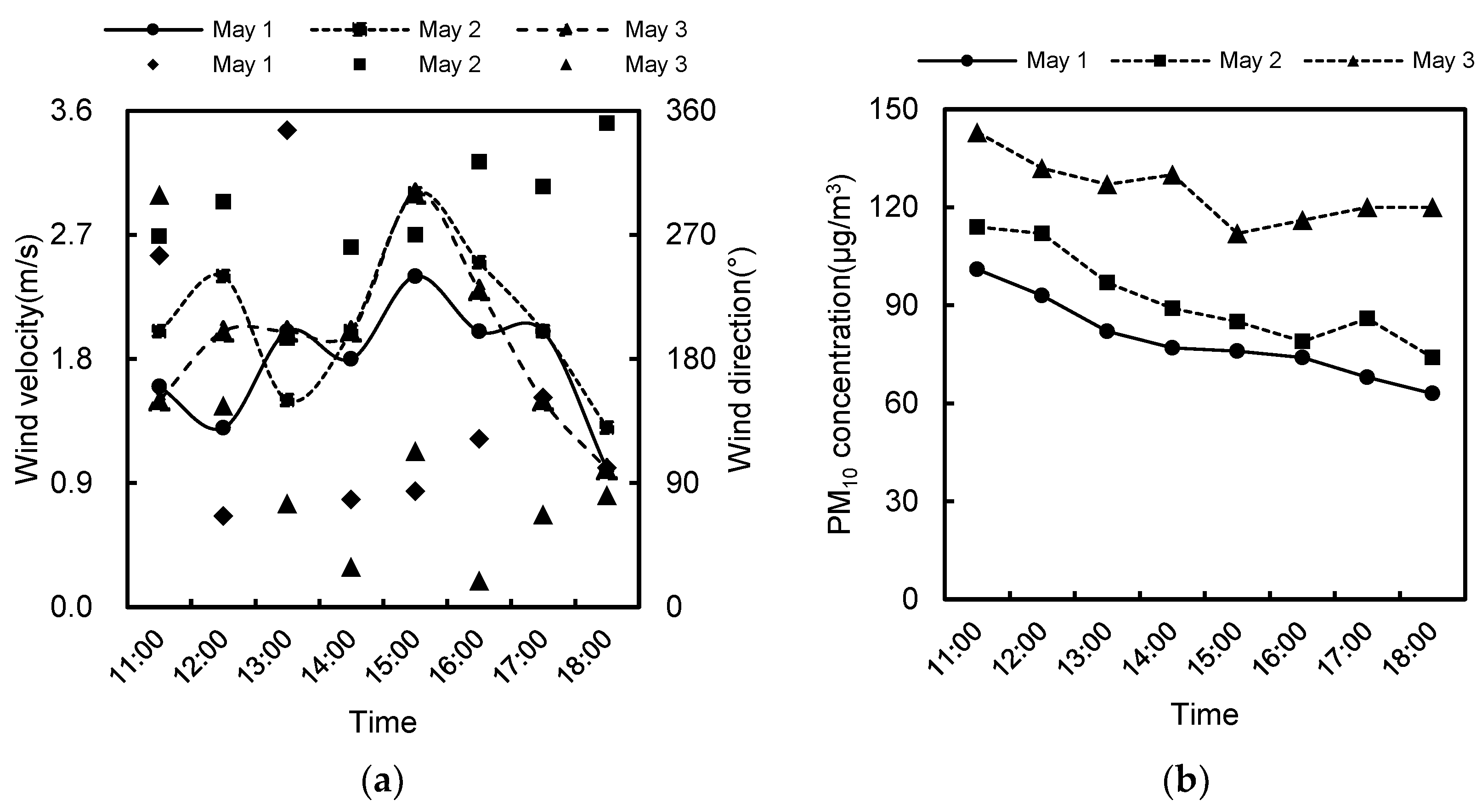


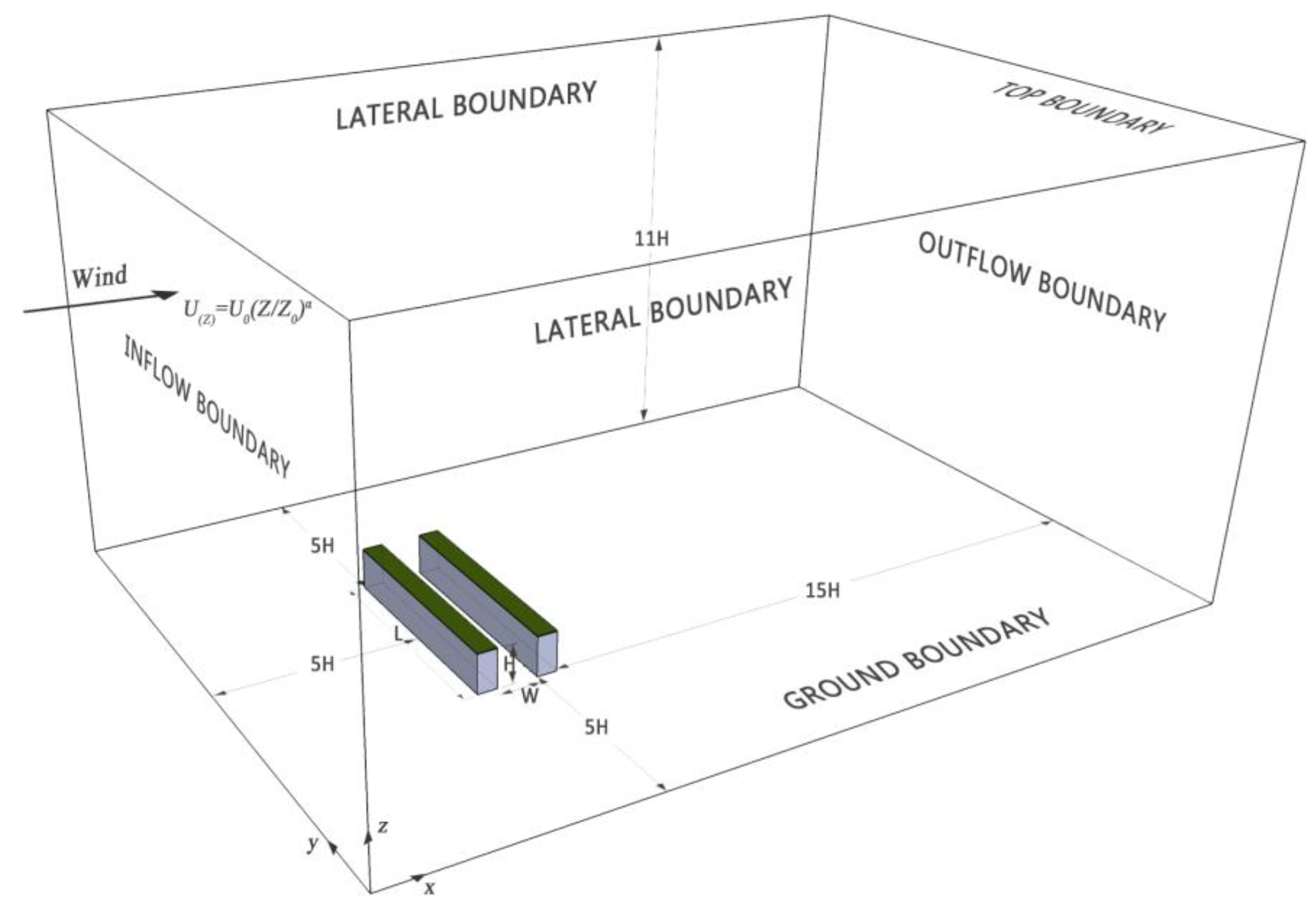
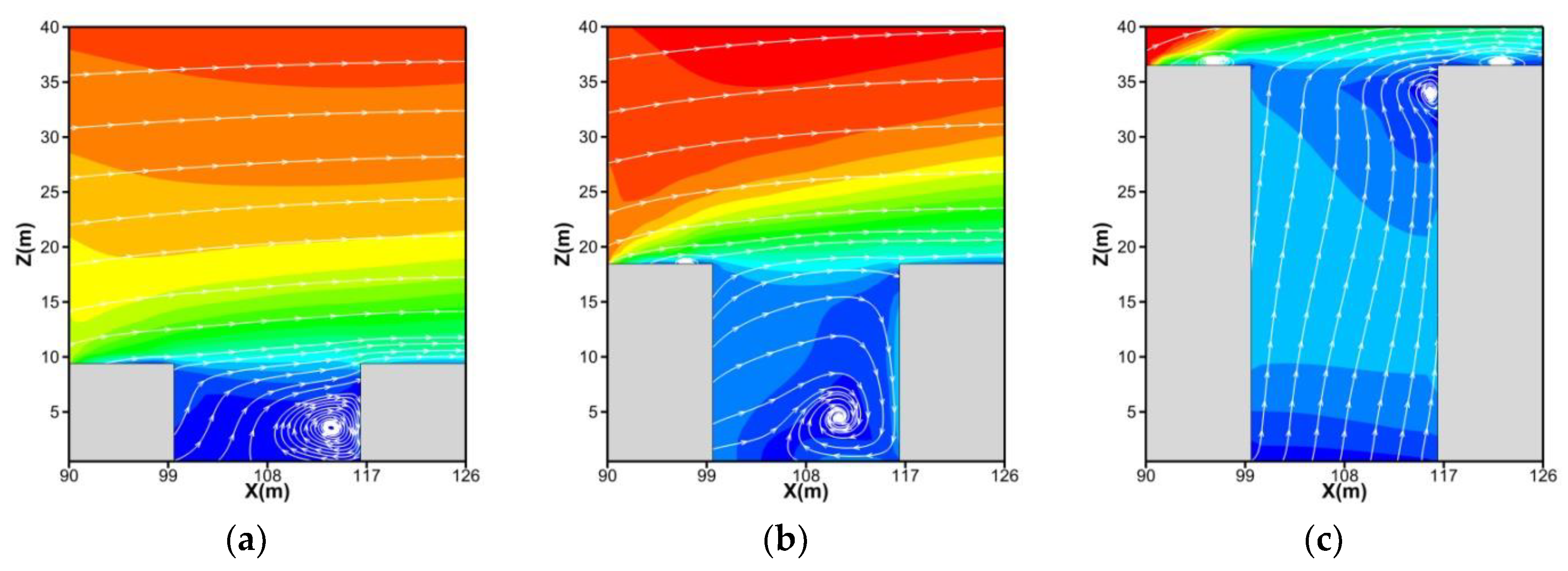
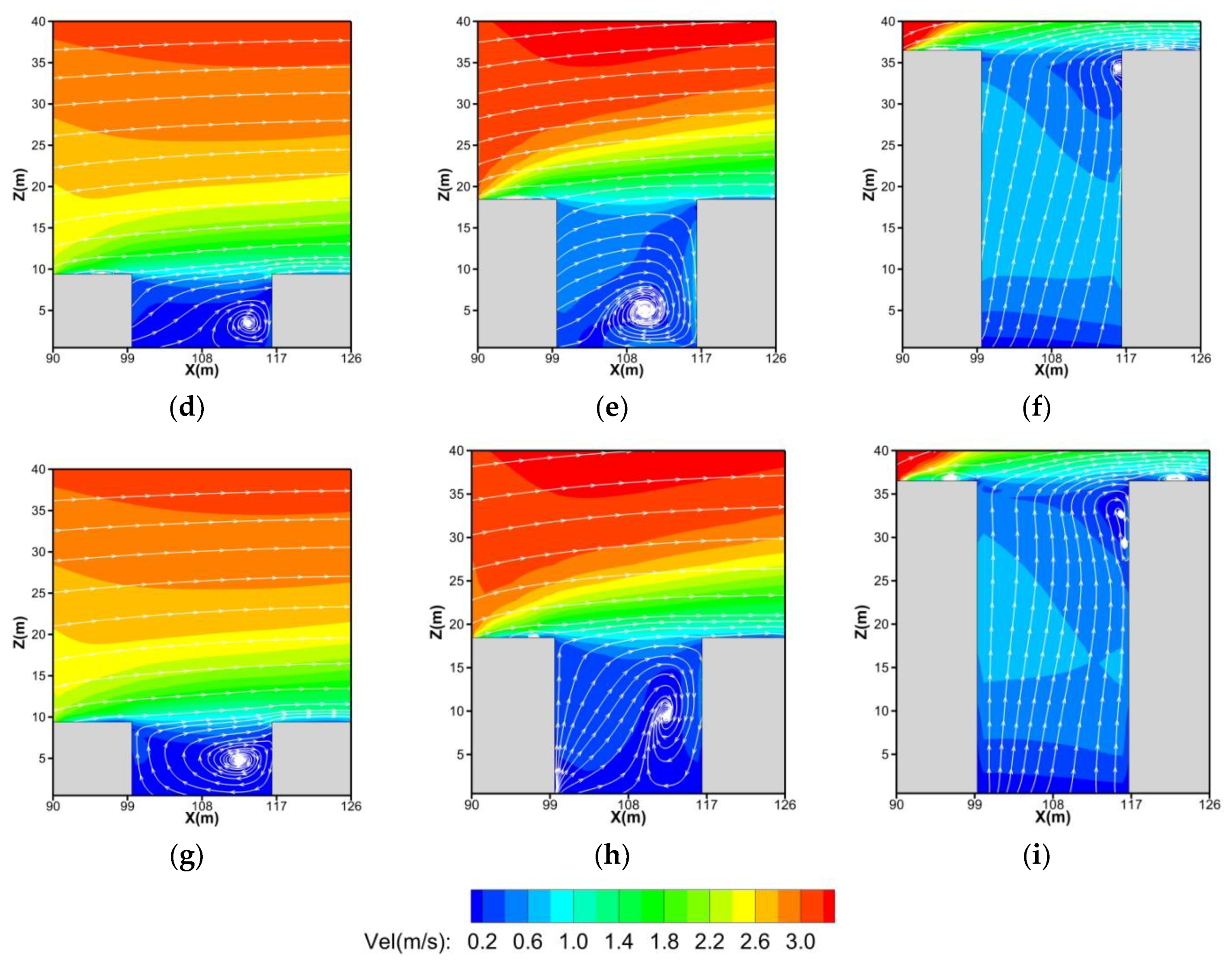
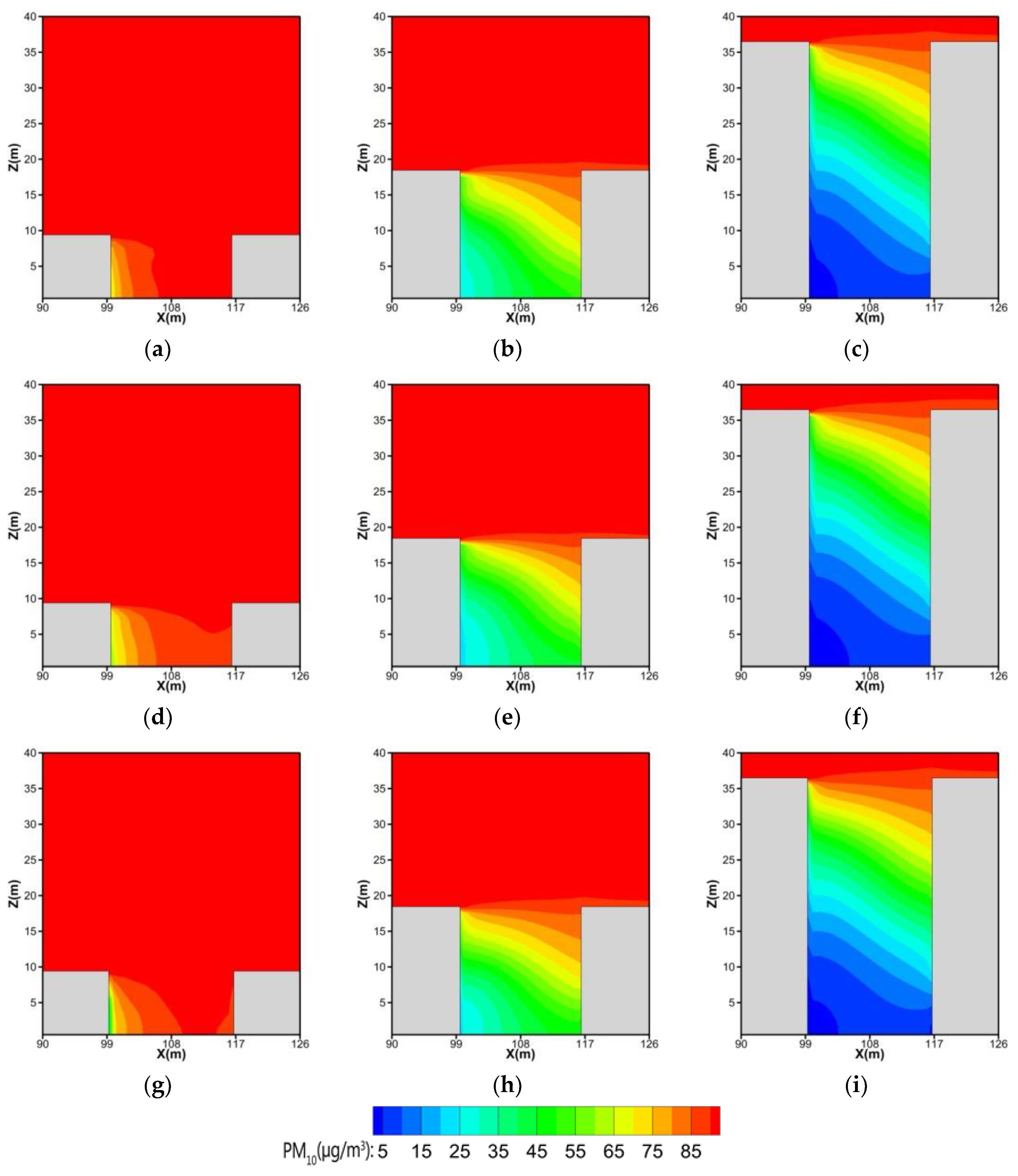
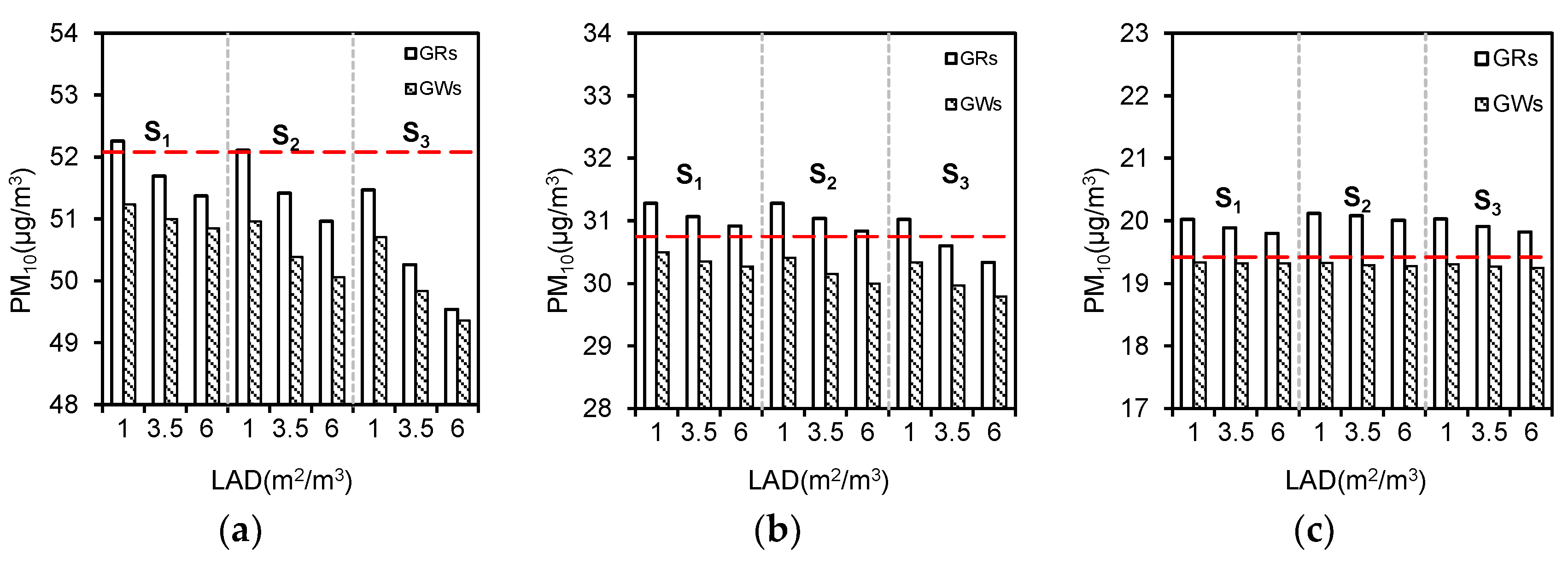
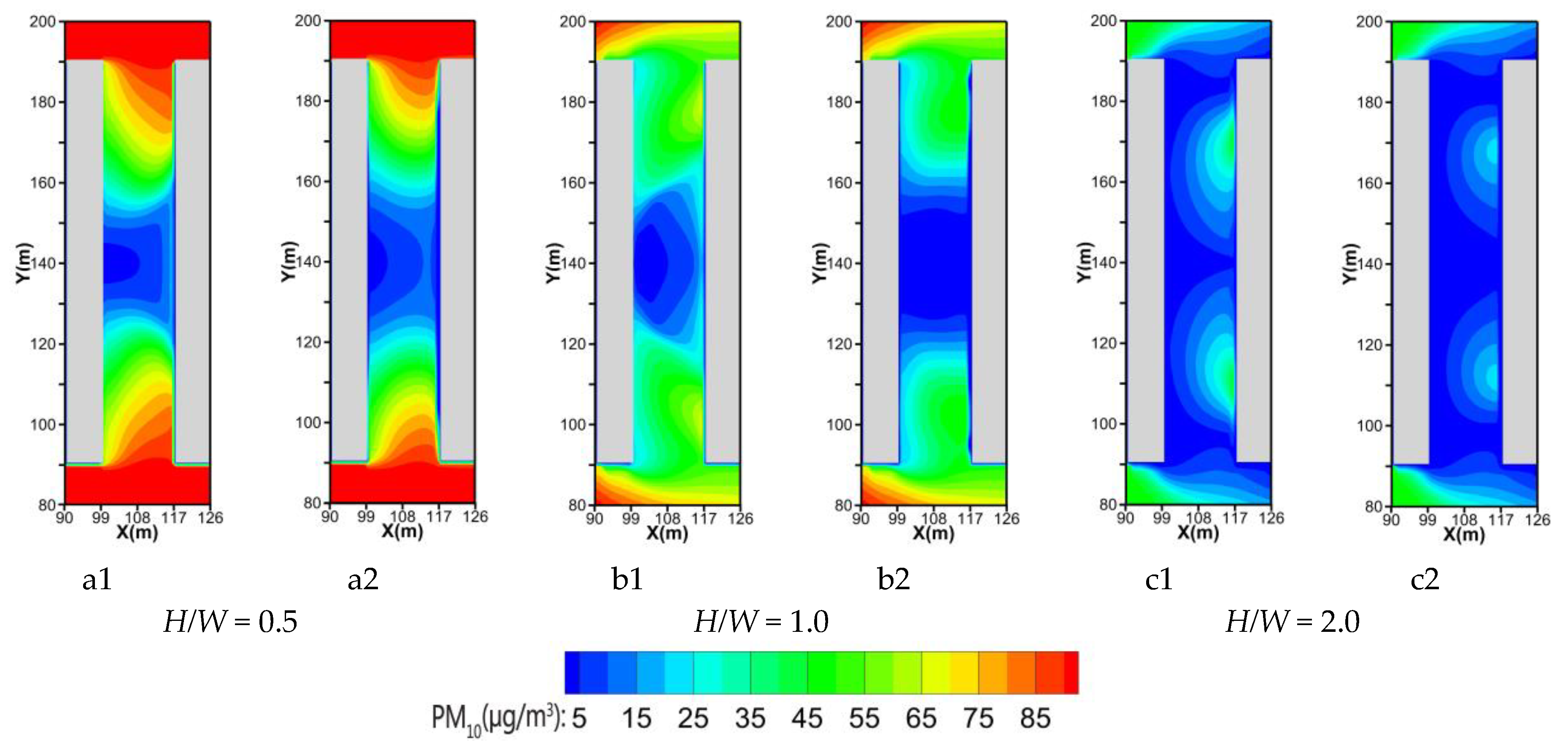
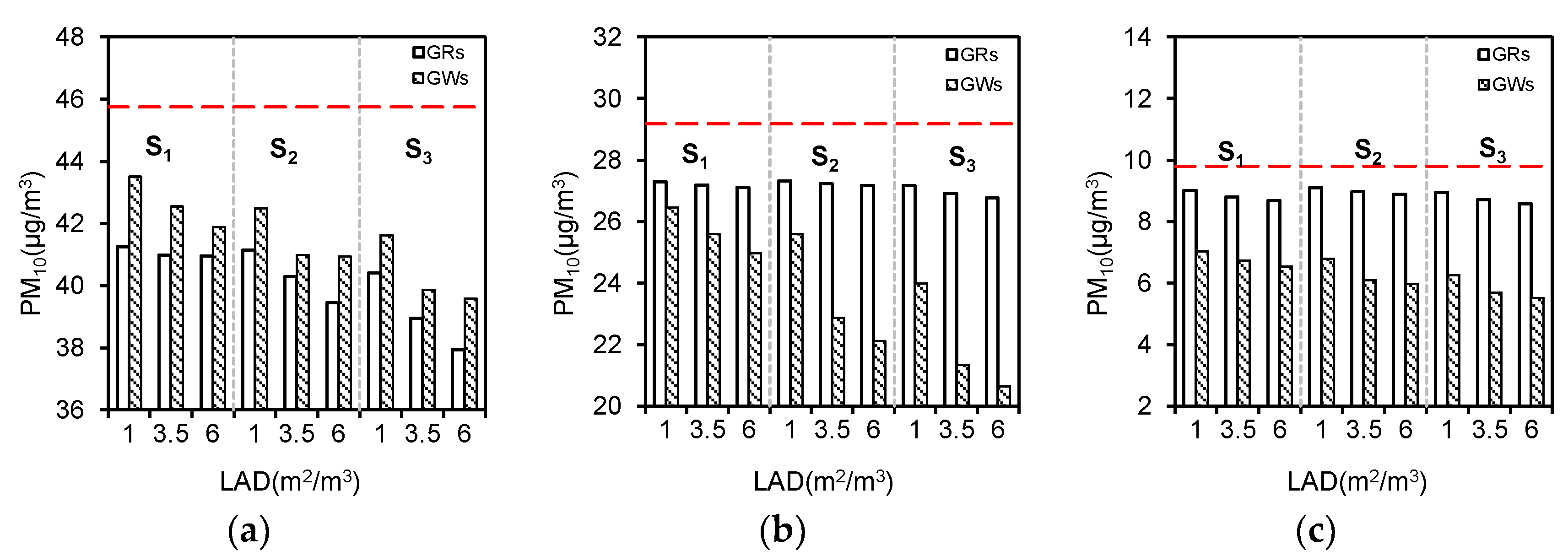
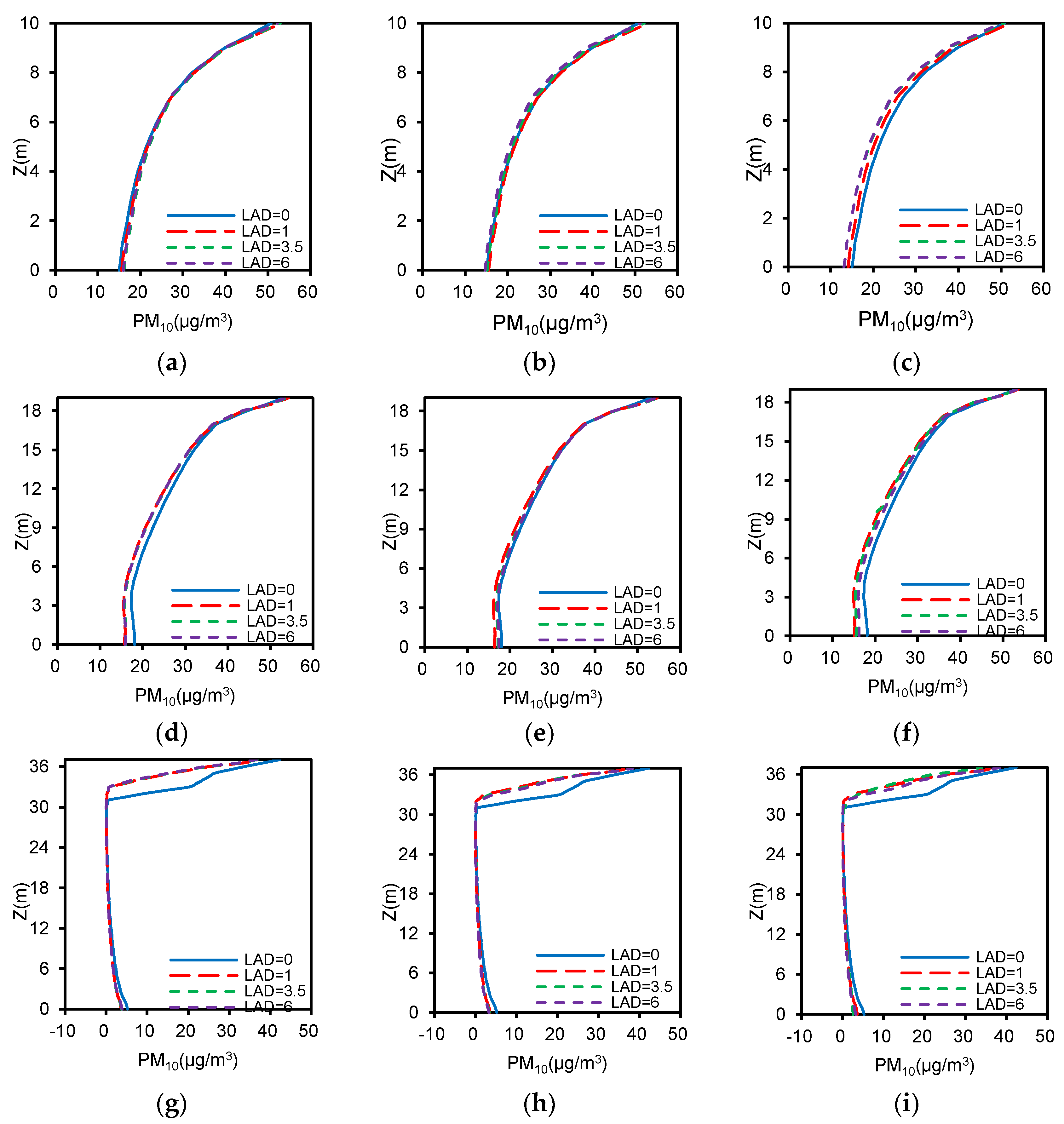

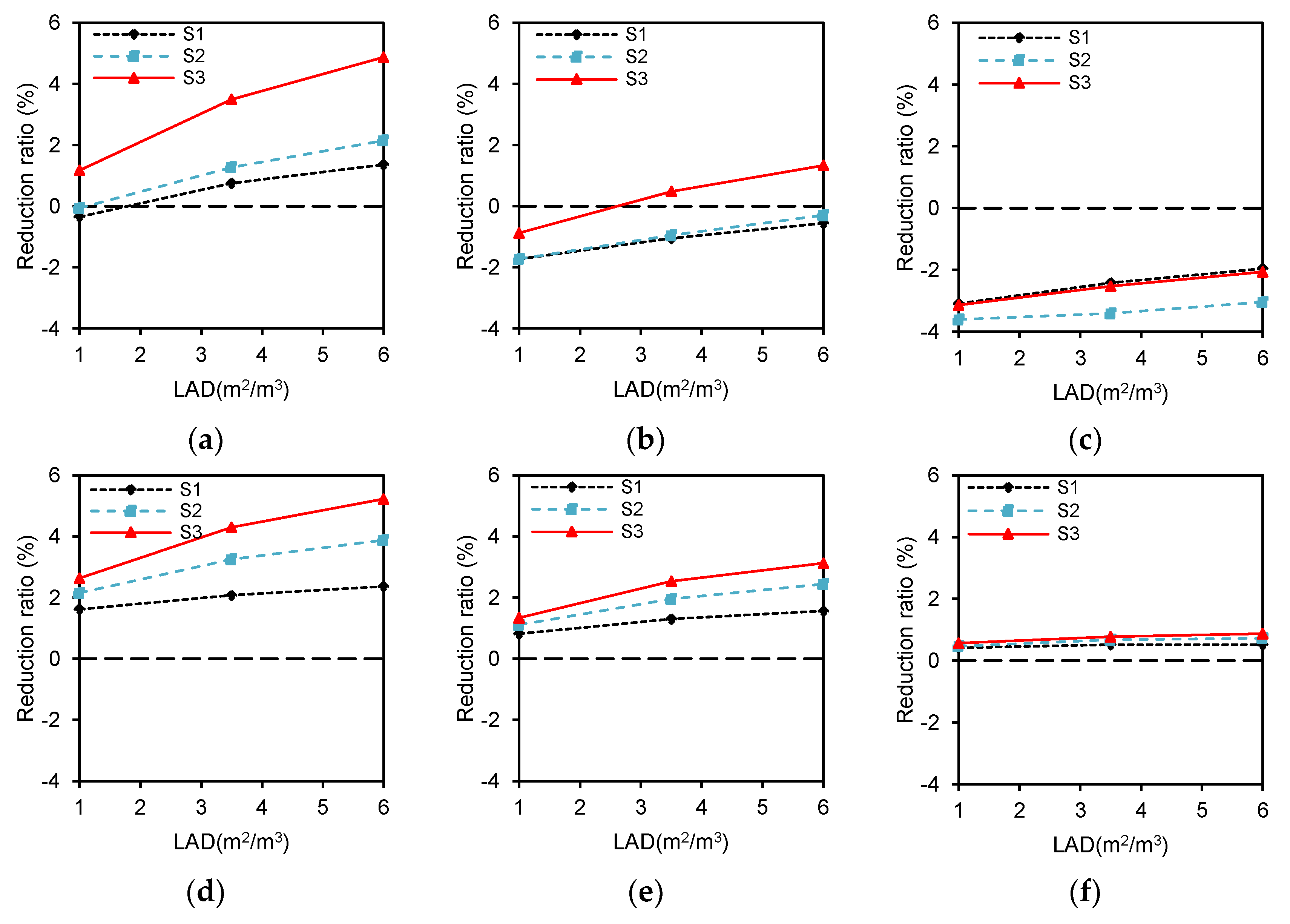
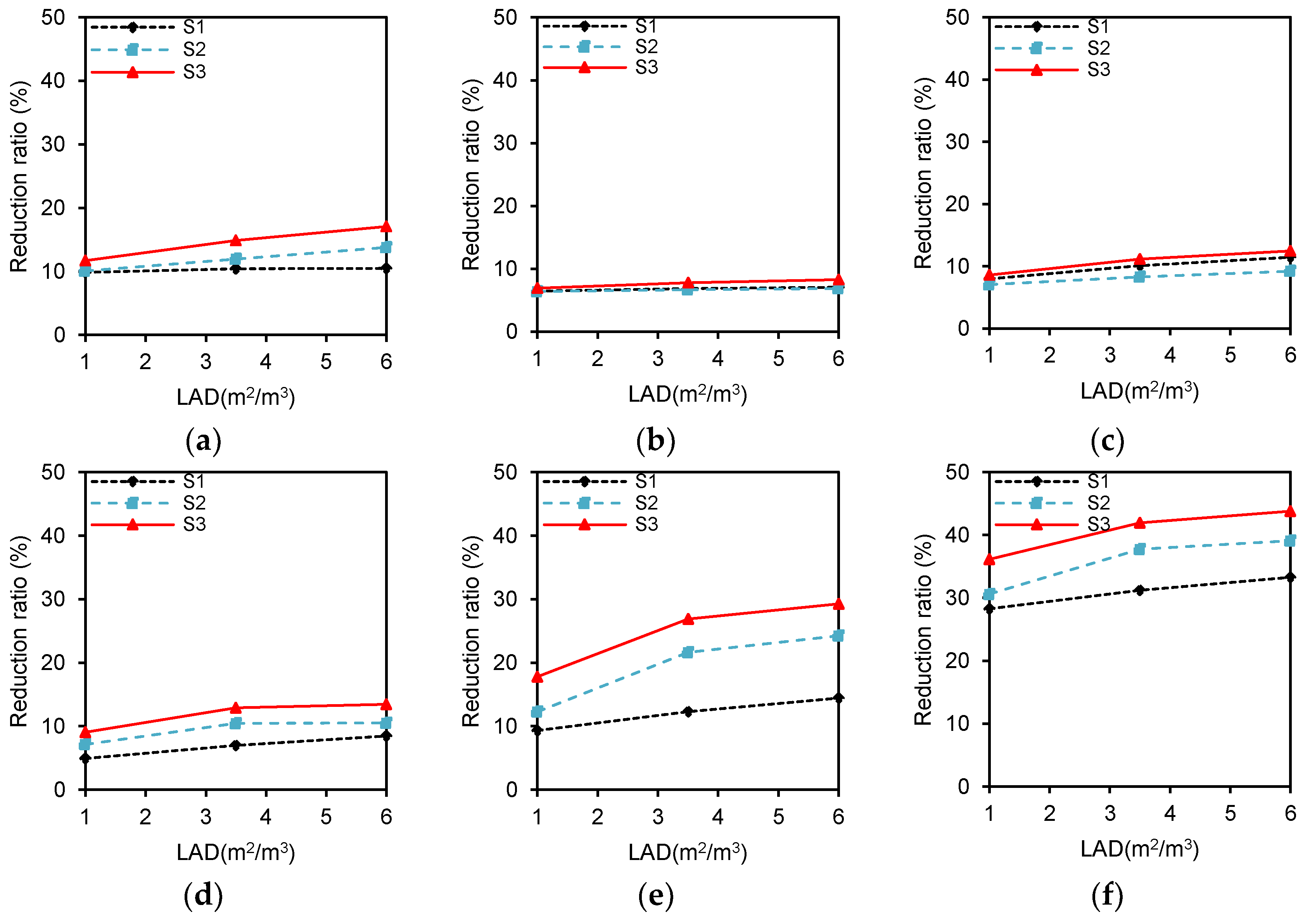
| Metrics | Target Value | Acceptance Criteria [39,40] | Reference Model Performance | |
|---|---|---|---|---|
| Upper Sampling | Lower Sampling | |||
| FB | 0 | −0.3 < FB < 0.3 | −0.007 | −0.047 |
| NMSE | 0 | NMSE < 1.5 | 0.011 | 0.005 |
| FAC2 | 1 | 0.5 < FAC2 < 2 | 1.007 | 1.048 |
| MG | 1 | 0.7 < MG < 1.3 | 0.954 | 0.944 |
| VG | 1 | VG < 4 | 1.018 | 1.006 |
| NAD | 0 | NAD < 0.3 | 0.042 | 0.031 |
| R | 1 | 0.8 < R | 0.952 | 0.985 |
© 2018 by the authors. Licensee MDPI, Basel, Switzerland. This article is an open access article distributed under the terms and conditions of the Creative Commons Attribution (CC BY) license (http://creativecommons.org/licenses/by/4.0/).
Share and Cite
Qin, H.; Hong, B.; Jiang, R. Are Green Walls Better Options than Green Roofs for Mitigating PM10 Pollution? CFD Simulations in Urban Street Canyons. Sustainability 2018, 10, 2833. https://doi.org/10.3390/su10082833
Qin H, Hong B, Jiang R. Are Green Walls Better Options than Green Roofs for Mitigating PM10 Pollution? CFD Simulations in Urban Street Canyons. Sustainability. 2018; 10(8):2833. https://doi.org/10.3390/su10082833
Chicago/Turabian StyleQin, Hongqiao, Bo Hong, and Runsheng Jiang. 2018. "Are Green Walls Better Options than Green Roofs for Mitigating PM10 Pollution? CFD Simulations in Urban Street Canyons" Sustainability 10, no. 8: 2833. https://doi.org/10.3390/su10082833
APA StyleQin, H., Hong, B., & Jiang, R. (2018). Are Green Walls Better Options than Green Roofs for Mitigating PM10 Pollution? CFD Simulations in Urban Street Canyons. Sustainability, 10(8), 2833. https://doi.org/10.3390/su10082833





